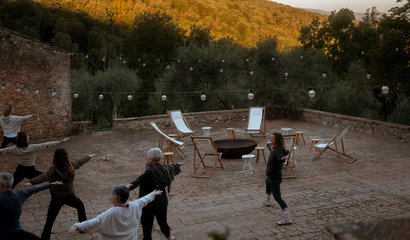June 27, 2022
Yoga Teacher Tips: Better Cues for Tight Shoulders
Should you pull your shoulders down?
As a yoga teacher, you're going to encounter tight shoulders in your classes. With stress, postural and lifestyle habits, you'll see that tension show up in how people move and hold their poses. So what do you say? How do you teach in a way that helps to reduce shoulder tension? (Video lesson below)

The most common sign of tight shoulders is when someone has their arms up overhead and you see their shoulders bunching around the ears. Do you say, "pull your shoulders down"? If so, that might not be the most effective cue!
This video lesson (video below) will give you a better understanding of the shoulder complex so that you can know why pulling the shoulders down isn't enough and ways to cue more effectively. Along with some bonus shoulder mobility work that you can give your classes so that you see less shoulder tension (all that bunching around the ears) and more ease in shoulder movements.
Shoulder Tension in Yoga Classes
There's a reason that the shoulder girdle is also called the shoulder complex. Because it's a complex part of the body with a lot of different parts. Most of the time when we talk about shoulders, we're referring to the glenohumeral joints. But there are other joints involved in our shoulder movements, not to mention the scapula (shoulder blades) and all of the many muscles connecting the arms to the rib cage, collarbones, head and neck.
And with a world full of people who have chronically tight shoulders, it's no wonder people come to yoga to help their shoulder mobility. But the simplistic cue of pulling the shoulders away from the ears is a quick aesthetic fix but doesn't actually address the underlying areas of tension that brought the shoulders to the ears in the first place.
Effective Teaching
It's common in yoga teacher trainings to teach yoga cues but not always teach the reasons why we say a cue. Or we may learn the why but it might be more of a surface fix without truly knowing the biomechanics of the joints underneath.
When you learn more about human movement, and what the joints need for longevity, your teaching starts to expand and you are no longer bound by cues that you don't quite understand. You begin to teach more effectively to the people in front you and can swiftly adapt your cues and your teaching so that you are supporting individual needs, rather than generalized cues that don't work for everyone. (Learn more about our teacher training and education courses here
Watch the video lesson below to learn more about why "pull your shoulders down" isn't doing what you think it is, along with ways to improve shoulder mobility in your classes and some different and updated cues for when you see tight shoulders showing up in your classes.



